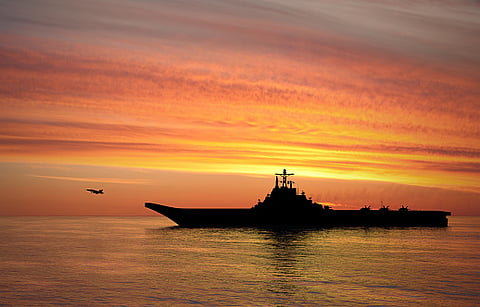As India continues to upgrade its defences around its territory, it is also upgrading its fleet in the oceans. The Indian navy is currently going through a massive modernization and indigenization phase. From nuclear submarines and warships to aircraft carriers, the Indian navy is rapidly expanding its fleet size to achieve the goal of becoming a true blue water navy with more than 200 vessels.
India recently launched the Indigenously built INS Vikrant aircraft carrier (IAC-1) and is now looking for some of the most advance and compatible fighter jets for the soon to be commissioned carrier. The carrier is scheduled to be commissioned into the Indian Navy around august this year. India currently doesn't have enough naval fighter jets to operate both of its carriers (the currently operational INS Vikramaditya and the new INS Vikrant) at their full potential and capacity. If India decides to use its existing MIG-29 jets on the Vikrant, it would need to compromise the jet numbers on its INS Vikramaditya carrier.
Because of this reason, it seems that India may go with a direct government to government deal for a new naval fighter Jets, just like the Rafale deal with France.
The Indian Navy initially announced a tender for 57 jets in 2017. It was estimated to be worth at least 6 to 7 billion USD at that time. The Indian Navy now plans to purchase 26 Jets, 18 of which will be single-seaters and the remaining 8 will be two-seaters.
INS Vikrant's capacity:
The INS Vikrant, with its massive 14 decks, has a total of 2300 compartments. It can carry 1700 sailors and officers. It can accommodate about 30 fighters and helicopters. Having a runway length of 206 meters with a ski-jump takeoff design, the carrier has a short takeoff position of 145 meters. As a result, the aircraft chosen by the Indian Navy must be capable of taking off in this manner while carrying all the weapon systems in the full fuel load. The ski-jump design of the carrier limits the variety of jets that can be operated from it.
Rafale vs Super Hornet:
Last month, the Rafale-M jet was tested for 12 days in the goa testing facility of the Indian Navy. On May 21st, the Super Hornet will be tested by the Indian Navy at the testing facility in goa. The US defence major Boeing will be sending two Super Hornet jets to India for the flight and ski-jump tests. Indian Navy will be testing all the operational capabilities of the jet, and may even test the jet on the carrier Vikrant if everything goes well in the ski-jump test.


